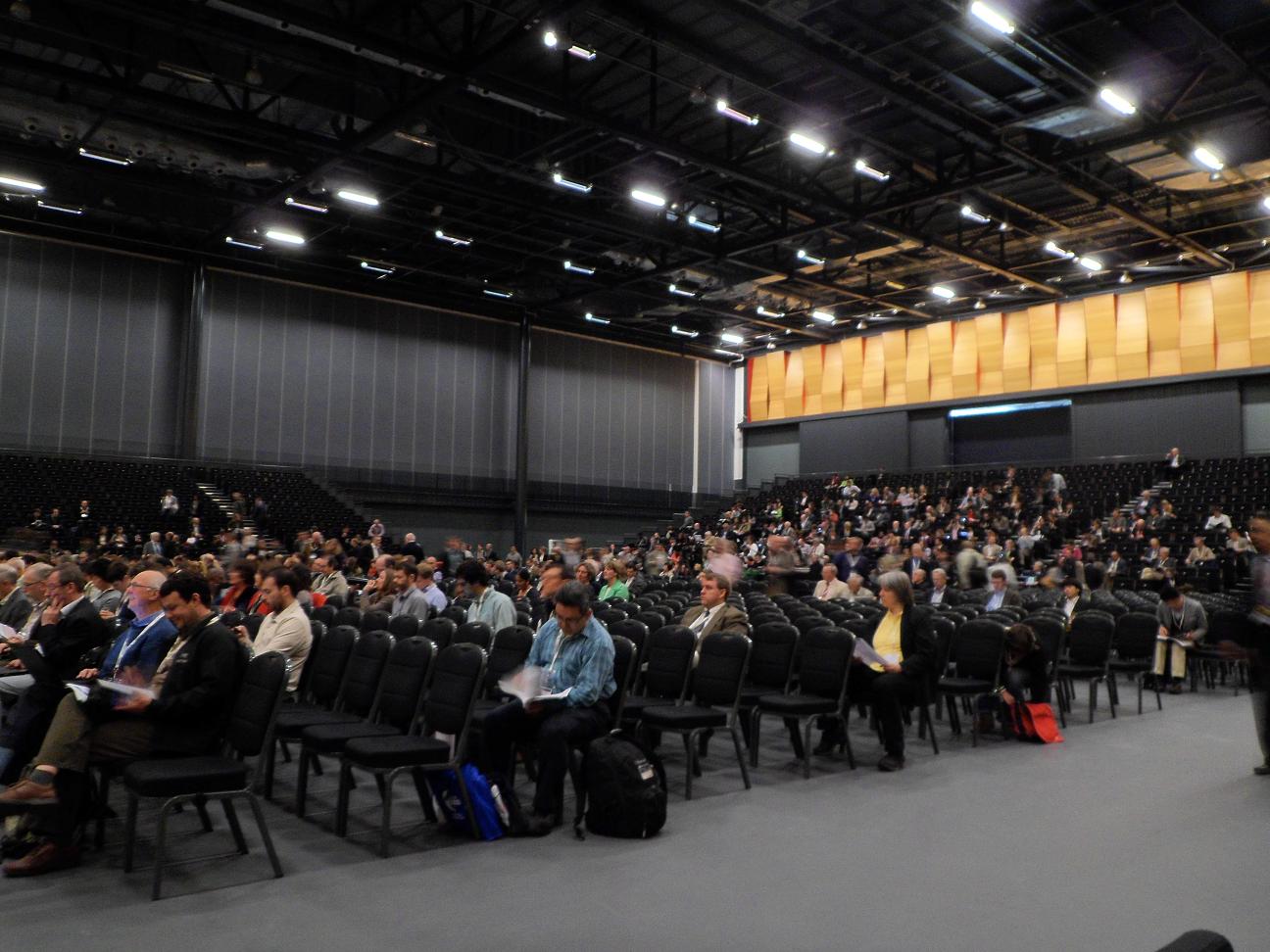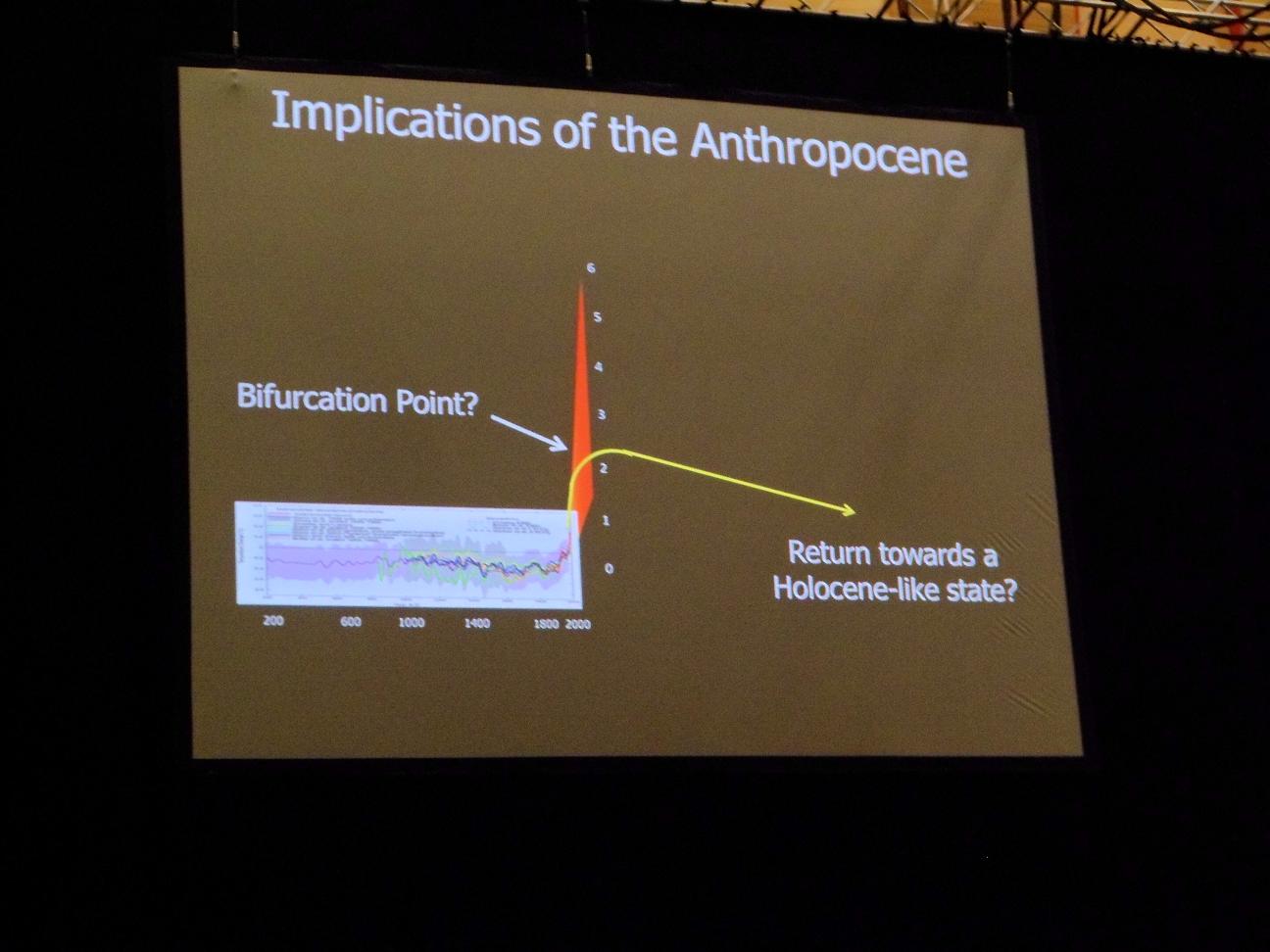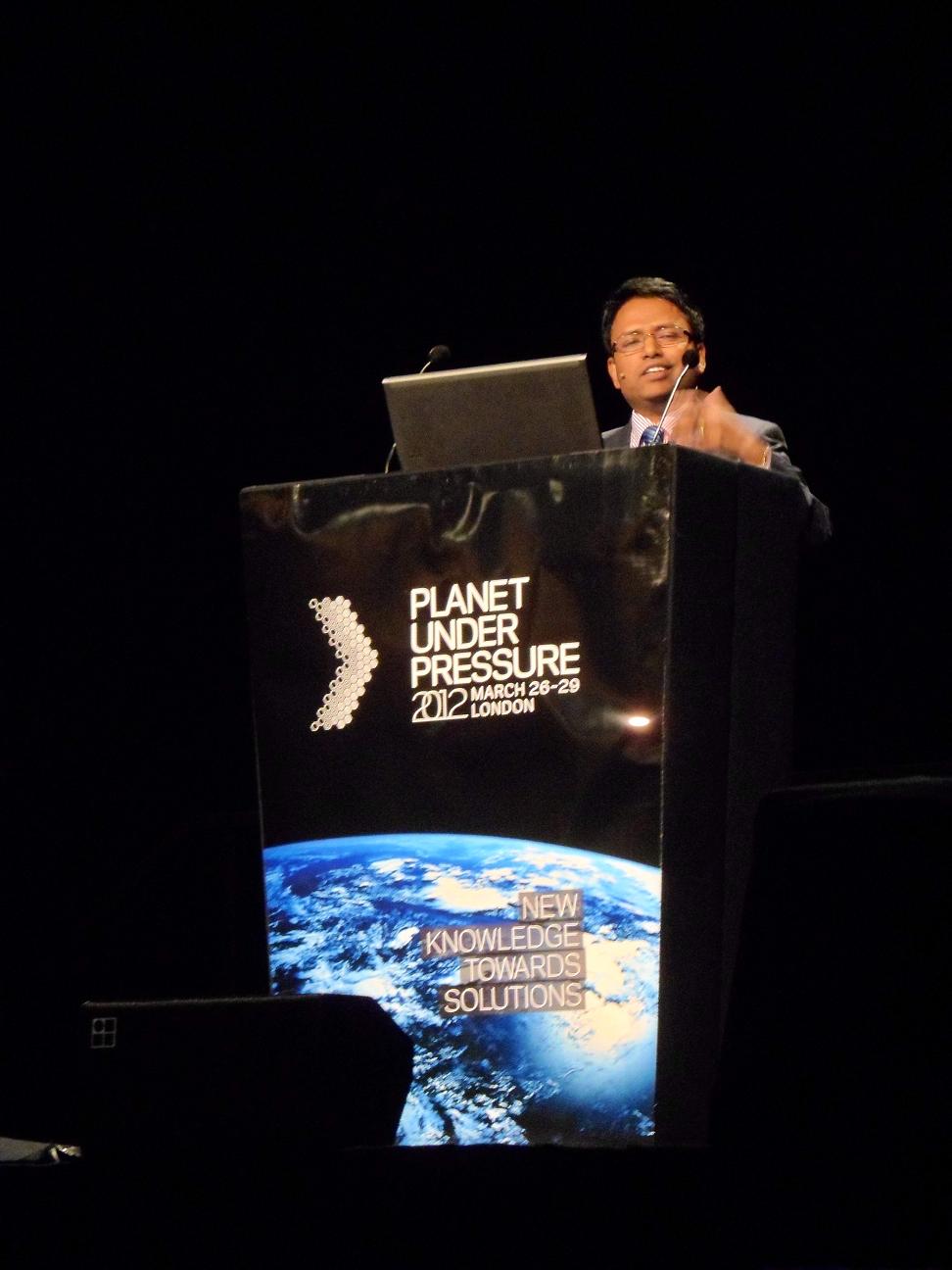In June this year, world leaders and the glitterati of global change sciences will meet in Brazil for the Rio+20 meeting. Twenty years on from the original Earth Summit, the world still faces daunting environmental challenges. In preparation for the Rio+20 meeting, scientists, policy makers, business leaders and the media are in London to discuss the knowledge base in the relevant scientific disciplines and further the dialogue regarding what might be achieved in Rio later this year. Over the next four days I will providing my thoughts and observations on the discussions and presentations which will hopefully be of interest to those reading. It would be particularly interesting to get comments from other people who are attending the conference so please contribute to the discussion.

The conference actually began yesterday with an opening talk by Sir Bob Watson and a drinks reception at the conference centre but I was stuck on the slow train from Herefordshire to London. Nevertheless I finally made it to the Excel Centre this morning to join the other 3,000 delegates in a rather large auditorium where we were treated to some opening comments from an ensemble of esteemed speakers including the 2009 Nobel laureate for economics, Professor Elior Ostrom from Indiana University, and Lord Martin Rees, a past president of the Royal Society. I guess the talks were designed to inspire the delegates and despite the slightly odd “award ceremony” style of the introductions, I think it worked reasonably well. That said, many of the speakers did present somewhat biased perspectives on the challenges and necessary solutions to the key global problems and as a scientist I try my best to avoid political advocacy where possible. Whilst I enjoyed listening to Lord Anthony Giddens (London School of Economics), his assertion that “scientists must launch an assault on climate change sceptics” was somewhat politically charged and did seem a bit unnecessary. Surely climate scientists can provide compelling science to influence political decision making without resorting to an “assault”?
Diana Liverman from the University of Arizona went against the grain to give a well balanced, thoroughly researched presentation outlining much of the evidence about the state of the planet; evidently a planet that is in a bad way but showing some signs of recovery. Slide of the day (below) goes to Will Steffen from the Australian National University who superimposed the range of 21st century IPCC projections onto the global temperature time series of the last 2,000 years. The same scale is used demonstrating the sheer magnitude of the range of projected changes to global mean temperature. His discussion about possible bifurcation points towards a new stable state or a reversion towards a Holocene-like state was insightful; of course any mention of limit cycles and bifurcations suggests a man after my own heart!

A panel discussion ended the plenary session which included a protest against Shell (who were represented by Jeremy Bentham) as two individuals unfurled a banner with the Shell logo, defaced to resemble a skull, and a slogan stating “Stop the greenwashing”…unfortunately by the time I got my camera they had rather politely left the stage.
I attended two afternoon sessions, the first of which focussed on recent progress in climate change prediction chaired by Julia Slingo and Tim Palmer. Akio Kitoh from the Japanese Meteorological Research Institute compared model projections of Pacific typhoons and stated that “high resolution models are needed for impacts studies on adaptation to climate change”. Certainly this sentiment was shared by Julia Slingo and Adam Scaife who presented some recent work at the Met Office suggesting that the North Atlantic Oscillation (NAO) could only be reliably modelled using high spatial resolution and increased vertical layers in the stratosphere. Wilco Hazeleger from KNMI gave a Dutch perspective on using climate projections to inform decisions stressing the need to consider an alternative to a top-down projections based approach. The discussion that followed certainly seemed to support Wilco’s views rather than the “need” to move to high resolution projections, despite the scientific merit that such an effort might yield. I was left perplexed about two things. Firstly the Met Office work presented was said to have some relevance to climate change adaptation yet the “climate change” experiments were associated with a 4 times carbon dioxide concentration experiment. These levels of carbon dioxide will almost definitely not be observed for many decades, perhaps even hundreds of years so the relevance of such experiments for current decision making is limited at best. Secondly, whilst I share many of Tim Palmer’s views and have enormous respect for his work, his comment that climate modellers are striving to “simulate reality” was discomforting. I don’t think I am being entirely unreasonable to suggest that climate models will never simulate reality and perhaps he didn’t mean this literally but we do need to be careful about how we communicate the aim of developing climate models to better represent the climate system. In promising that high resolution models will provide more “realistic” models, we need to be clear that model projections will always be subject to large, often irreducible uncertainties.
Finally, to round up a successful day one, I attended a session discussing the sustainability needs of the least developed countries (LDCs). Some interesting talks from different corners of the world provided perspective concerning global environmental change and the potential disastrous consequences that are vital to avoid. The picture below shows a speaker addressing the social pressures impacting climate change adaptation in Bangladesh (I failed to make a note of his name). David Smith from the West Indies described how Jamaica has, in the last decade, suffered annual losses from enironmental hazards that exceed annual government spending. Issues of data quality and maintanence were highlighted and evidence was presented showing that large losses in LDCs are often associated with complacency resulting from a lack of disasters in recent memory. This got me thinking about how risk can be a function of time even if the probability of a hazard and the exposure to risk doesn’t change as vulnerability will be exacerbated if people are complacent and less likely to heed warnings. As the session closed, I made my to the tube stop looking forward to day two!

Joseph
Thanks for the link Erica. Kevin Anderson often has compelling arguments and in a broad sense, I share his concerns. However, a few statements lead me to question his real motives for not attending.
He says:
“without doubt it will have long lasting impacts on the climate as a consequence of the significant emissions associated with organising and hosting the event; … or will it?”
My initial reaction is that he is overstating the conrtribution of the emissions somewhat. There are 3,000 people at this conference, many of who have travelled from the other side of the world (there seem to be quite a few Australians!) but every day the world increases in net population by about 200,000 so statements like this are misleading – the language he uses needs some perspective and moderation. Also, the term “without doubt” followed by a “will it?” appears somewhat self-contradictory.
“there is a high probability that offsetting projects contributing to prosperity will increase emissions, over and above those arising solely from the original activity being offset. From an emissions and climate perspective, offsetting is worse than doing nothing.”
He assumes prosperity is, and always will be, linked to increased emissions…this assumption may be valid in today’s world but surely thats the whole point of the conference, to break this link and enable prosperity without increasing emissions. His conclusions are therefore defeatist and, in my view, unreasonably pessimistic. And I hope he isn’t against increasing prosperity for the vast number of global citizens for whom development is vital.
Finally, I think his storyline about flying to australia and therefore triggering an increase in airport capacity and enabling airlines to order new aircrafts is simply ridiculous. Surely he must have more belief in his own ability to argue that despite his attendance at a climate conference, increasing airport capacity is a bad idea. Without attending the climate conference in Australia, politicians and people of influence (who we hope are also at the conference) might not hear his views (which ought to be embedded in defensible science btw) and think there is no sufficient justifiable reason to abandon airport expansion. His argument just doesn’t stack up…unless of course he goes to the conference and doesn’t contribute in any way to the furthering of knowledge and/or communication of climate science/policy issues. Having seen Kevin speak a number of times, I don’t think he would intend to be mute on these issues!
…another possibility is that he was looking for an opportunity to write a blog like this and given the many conferences that I am sure he does attend, it unfortunately falls to Plane Under Pressure to be the one he deems “not quite worth it” and therefore unleash this argument. Mere speculation of course!
I think most people in the climate science world think carefully about the value of foreign trips. Certainly people here at CSAG are very aware of their carbon footprints which are probably higher than counterparts in Europe and America simply because most international conferences and meetings occur a long way from South Africa (Durban was a refreshing exception). Yet, I am not convinced that boycotting events which do or do not have offset schemes is the most sensible way to address the global problem of climate change mitigation. Surely interaction of scientists and policymakers aiming to deliver solutions to aid development and sustainability at events like Planet Under Pressure are a reasonably sensible use of resources? Of course I look forward to the day that skype conferences are the norm but I sense this is a long way off…the internet connection I have in Cape Town still isn’t great.
Erica
Thanks Joe, sounds really interesting. There does seem to be a bit of a split between the we-just-need-bigger-models brigade and the oh-dear-not-sure-that’s-going-to-work brigade, so if there is a discussion about combining them in a meaningful way that would be really useful.
Wondered if you have any thoughts on Kevin Anderson’s latest blog about the Planet Under Pressure conference? He says “This piece is intended to provide a succinct account of why I consider, from a climate change perspective, that offsetting is worse than doing nothing and as such why I decided it inappropriate for me to attend my planned session at the event.” Lots of interesting observations…
Joseph
He used a graphic I have seen in a couple of papers comparing a science-led (IPCC-style) and a bottom-up, decision-oriented approach. His talk was titled “Tales of Future Weather” and the main argument was that past analogues and studies focussed on vulnerability, under a number of different scenarios, were of more value. He did say that high resolution model output would be useful in fleshing out possible weather for certain scenarios, perhaps to stress test specific adaptation options. This approach reminds me of the Realistic Disaster Scenarios that Lloyd’s and other insurers use to stress test business lines and insurance portfolios. I think there was a mixture of climate scientists and practitioners in the audience but the talks were certainly biased towards the interests of climate scientists/modellers.
Erica
Interesting – can you tell us more about the alternative that he presented? And were the main contributors to the discussion climate scientists, or other stakeholders?